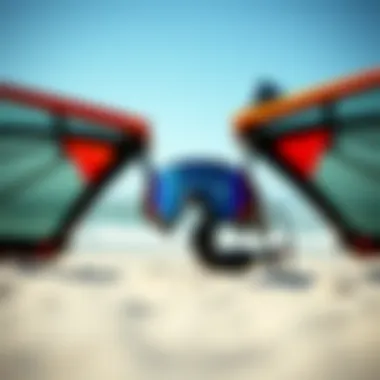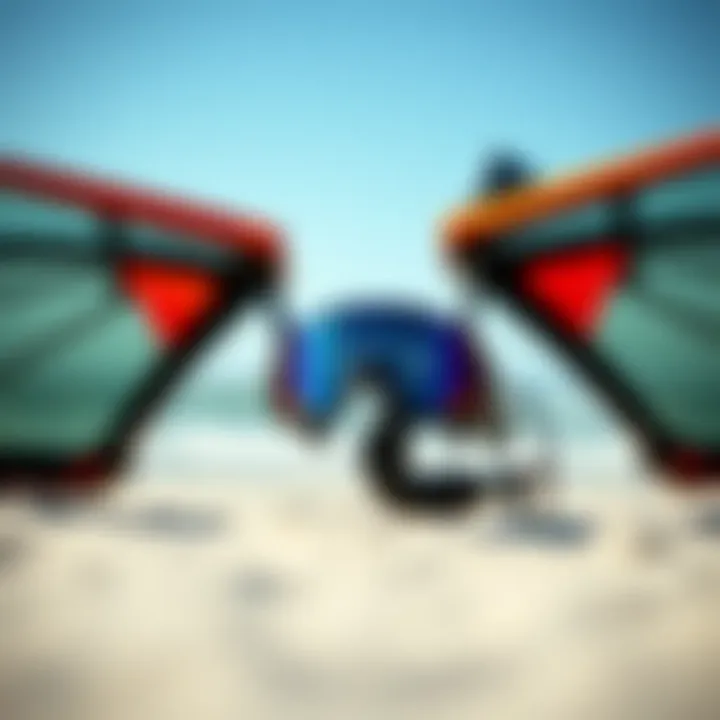Exploring the Wing Surf World: A Detailed Analysis


Intro
Wing surfing has captured the imaginations of adventure seekers and water sports lovers alike. With a unique blend of windsurfing and kiteboarding, it offers an exciting way to ride the waves – or glide across the water's surface effortlessly. But let’s be honest; getting started can feel a bit overwhelming. Between deciphering gear choices and mastering techniques, the learning curve is steep. Fortunately, this guide shines a spotlight on the essentials that will help not just beginners but also seasoned enthusiasts navigate this exhilarating discipline.
The growth of wing surfing has been nothing short of astonishing. Not so long ago, you’d have been hard-pressed to find anyone discussing those colorful wings on the beach. Now, they’ve become synonymous with coastal views. The camaraderie and community built around this sport are palpable. Everyone from novices to pros comes together to share tips, experiences, and, of course, their favorite spots.
In this article, we'll explore the nuts and bolts of wing surfing, covering everything from gear and techniques to safety practices and ideal locations. This comprehensive exploration is tailored for everyone—from curious onlookers to those eager to catch their first gust of wind.
Gear and Equipment
Essential Gear for Beginners
Whether you’re just starting or are looking to refresh your equipment list, having the right gear can make all the difference.
- Wing: The heart of your setup. Depending on your weight, skill level, and wind conditions, you’ll need an appropriately sized wing. If you’re starting out, a larger wing provides better lift and stability. Brands like Duotone and Slingshot offer options to consider.
- Board: Choose a board that suits your style—foiling or traditional. A wider board is generally more stable, which is ideal for beginners.
- Harness: This connects you to the wing. You can opt for a waist harness or seat harness, depending on your preference. Comfort is key here.
- Safety Gear: Don’t overlook a good life jacket and helmet, especially if you are in choppy waters or challenging conditions.
Advanced Equipment for Experienced Riders
As you progress in wing surfing, the gear you choose can have a significant influence on your performance and control on the water.
- High-Aspect Foils: These offer increased lift and speed, benefiting advanced riders looking to push their limits.
- Specialized Boards: Lighter materials can lead to improved maneuverability for tricks and jumps. A carbon fiber board might be the way to go.
- Upgraded Wings: As you become more skilled, you may want to try wings with more advanced designs that allow for increased responsiveness and finesse. Look for options that offer various strut placements for optimal performance in different wind conditions.
"Always test new equipment if possible. Each piece can affect how you ride, and what works for one rider may not suit another!"
Techniques and Tips
Basic Riding Techniques for Newbies
Starting anything new can be daunting, but here are some straightforward techniques that can get you up and riding in no time:
- Stance: Keep your knees slightly bent. This will help you maintain balance as you learn. Spread your feet shoulder-width apart on the board.
- Powering Up: Begin by facing the wind. As the wing fills with air, you’ll feel it pulling you forward. Relax and let the pull guide you.
- Stopping: To slow down, edge the board against the wind or pull the wing back towards you slowly. Learning when and how to shift your weight is also crucial.
Expert Tricks to Elevate Your Skills
For those looking to impress, consider these tricks once you feel comfortable:
- Jumps: As you get the hang of it, practice small jumps by shifting your weight to your back foot and popping off the water.
- Transitions: Riding heel-side and toe-side seamlessly is essential. Practice turning the wing while keeping your board stable.
- Tacks and Jibes: Mastering these turns will enhance your overall control and speed.
As you delve deeper into wing surfing, you’ll discover a world where the wind and water blend seamlessly, offering a thrilling escape in nature. Armed with the right gear and techniques, your journey in this rapidly evolving sport will be both rewarding and exciting.
Understanding Wing Surfing
Wing surfing blends the thrill of wind sports into a distinctive experience. This segment of the article aims to provide a solid groundwork in understanding what wing surfing is all about, highlighting its significance in today’s dynamic outdoor sporting scene. For enthusiasts at any level, grasping the fundamentals can greatly enhance enjoyment and performance.
A Brief History
To appreciate wing surfing today, one must first look back at its origins. This sport emerged as a blend of various wind sports in the early 2010s. At its core, wing surfing combines elements from windsurfing, kiteboarding, and even foiling, creating a hybrid approach to gliding on water. As athletes sought a new way to harness the wind's power, they began experimenting with hand-held wings. What we now see as a distinct discipline started to evolve, driven by innovation and experimentation.
One key moment was the introduction of inflatable wings around 2015, which significantly enhanced portability and accessibility. This made it feasible for more people to try their hand at the sport. Additionally, advancements in board design—particularly the advent of hydrofoils—transformed how enthusiasts interact with water and wind. The combination of lift, speed, and maneuverability opened up a whole new world for wing surfers, drawing in a diverse crowd, from casual seekers of weekend fun to competitively-inclined individuals.
As it stood, wing surfing was not just a pastime but a movement towards more exhilarating experiences on water. Today, locations worldwide host competitions and community gatherings, showing how far the sport has come in just over a decade.
Fundamentals of Wing Surfing


At its simplest, wing surfing involves a board equipped with a wing that the rider holds while being propelled across water by wind. Understanding the essentials is key to thriving in this sport.
Key elements include:
- The Wing: Unlike traditional sails, wings are held by the rider, allowing for greater freedom of movement and control. They come in various sizes suited to different wind conditions and rider skills.
- The Board: Riders can choose from a variety of board types, including those designed for hydrofoiling or traditional surfing. The choice impacts balance, speed, and maneuverability.
- The Foil: For those who opt for a hydrofoil setup, understanding how to balance while harnessing lift is crucial. It elevates the board above the water's surface, promoting a smoother ride in choppy conditions.
Benefits of mastering these fundamentals:
- Foster safer exploration of windy waters, reducing the risk of accidents.
- Amplify enjoyment through improved performance.
- Establish a strong base for advancing skills and techniques as one progresses from novice to pro.
In essence, grasping the fundamentals of wing surfing enables individuals to navigate both the physical and mental challenges this sport presents. It’s not merely about riding waves; it’s about embracing a lifestyle that celebrates the unique bond between human, water, and wind.
Key Takeaways
"Understanding is the first step to mastery. For every wave you ride, there's an opportunity to connect deeper with nature and your own capabilities."
To recap, wing surfing is not just a recent fad; it's a captivating union of diverse watersports. By examining its history and core principles, enthusiasts can better appreciate the sport’s nuances and its burgeoning community. This foundational understanding sets the stage for further exploration of techniques and gear, taking riders deeper into the wing surf world.
Wing Surfing Techniques
Wing surfing represents a thrilling mashup of windsurfing, traditional surfing, and kiteboarding, making it a multifaceted sport that appeals to a wide range of adventure seekers. Understanding wing surfing techniques is crucial not just for performance, but for safety and enjoyment in this exhilarating environment. By grasping the fundamental skills and advancing through various levels, surfers can fully appreciate the dynamics of the sport while also enhancing their overall experience.
Getting Started
Embarking on your wing sailing journey can feel like stepping into uncharted waters. Starting with the right foundation is essential. First off, having proper instruction can save a world of trouble. Seek out local clubs or certified instructors. This helps build confidence, knowing that you are learning the ropes safely.
When you first pick up a wing, it’s advisable to practice on land before ever hitting the water. This aids in understanding how the wings provide lift and how to control it. You should learn to balance the wing against the wind, getting accustomed to its behavior.
- Choose the Right Conditions: Start with light winds and flat water. This is where you will find your footing and learn to maintain stability.
- Equipment Familiarization: Spend some time getting to know the gear. Know how to check your wing for tears, how to inflate it properly, and understand your board's contours.
- Buddy System: If possible, have a partner or instructor nearby. They can provide assistance if you run into any issues.
Intermediate Sailing Skills
Once you have the basics down pat, it’s time to advance to those intermediate sailing skills, where the fun really starts. This phase is all about transitioning and refining movements, allowing for more fluid navigation.
- Tacking and Jibing: Mastering these turns can greatly increase your efficiency on the water. Tacking involves turning your board into the wind, while jibing requires adjusting the wing behind you. Both maneuvers play a key role in managing direction and speed.
- Foot Positioning: Knowing where to place your feet will come in handy. The front foot's placement influences your balance and how you steer your board through the water. You want to be agile and quick on your feet.
- Elevation Control: As you start flying above the water’s surface, adjusting the angle of your wing can determine whether you're rising or descending. This balance can create exhilarating moments when done right, but also challenging experiences if mismanaged.
Advanced Maneuvering
Now, you may find yourself where the rubber meets the road, engaging in those advanced maneuvers that take your skills to the next level. Here, preparation and intuition come into play.
- Jumping: The thrill of catching air is a key highlight for many riders. When preparing to jump, timing is everything. Focus on the gusts and know when to apply force. This can be tricky, so practice makes perfect.
- Handle Passes: This maneuver requires some coordination as you pass the wing behind your back while in mid-air. It isn’t for the faint of heart, but once you master this, it showcases a higher level of skill.
- Downwind Technique: Riding downwind can be a wild experience; it’s about speed and control. Use your body to steer efficiently, leaning into the wind rather than against it, ensuring that you maintain both speed and direction.
"Mastering wing surfing means individuals not only improve their skills but also their awareness of the natural elements – understanding the wind, water, and their own body."
Whether you’re just getting started, sharpening your intermediate skills, or challenging yourself with advanced techniques, wing surfing techniques offer a playground of opportunities for improvement and enjoyment. These skills not only provide a deeper connection with the sport but also emphasize safety, enhancing the overall experience on the water.
Essential Gear for Wing Surfing
Wing surfing has emerged as a thrilling and versatile sport, but to truly maximize your experience on the water, having the right gear is indispensable. Essential gear not only enhances performance but also ensures safety and comfort while riding the winds and waves. In the ever-evolving world of wing surfing, understanding the nuances of each piece of equipment can make all the difference between a smooth ride and an arduous battle against the elements.
Wings: Types and Specifications
When it comes to wings, they are the heart and soul of your wing surfing experience. Selecting the appropriate wing hinges on a handful of factors, mainly wind conditions, rider skill level, and personal preferences.


- Types of Wings: You’ll find different types of wings like inflatable wings and solid wings. Inflatable wings, such as those from brands like Duotone and Naish, offer excellent floatation, making them beginner-friendly. On the other hand, solid wings are typically stiffer and often preferred by experienced riders looking for more control and responsiveness.
- Specifications: Each wing comes with its own specifications such as size and shape. Smaller wings (hovering around 2 to 4 square meters) are better suited for stronger winds, providing increased maneuverability. In contrast, larger wings (6 square meters and above) excel in light wind conditions, giving you the lift needed to get up on the board quickly. Understanding these aspects allows you to choose a wing that not only fits the day's conditions but also matches your skill level.
Boards: Selection Criteria
Choosing the right board is akin to picking a good steed; it’s your connection to the water. Various aspects should be taken into account to find what suits you best:
- Size: The board size significantly affects stability and balance. For beginners, wider and longer boards provide greater stability, helping to ease the learning curve. Conversely, advanced riders may prefer shorter boards for agility and speed.
- Material: Foam boards are generally more buoyant and easier to handle, making them a popular choice for newcomers. If you’re more seasoned and seek speed, you might look toward harder constructions like carbon or fiberglass."
- Shape: The shape influences how the board interacts with the water. Some boards are designed to glide efficiently, while others are made for tight turns or freestyle tricks. Try a few shapes to see what feels comfortable beneath your feet.
Safety Equipment Overview
Safety first is the motto to live by when wing surfing. Here’s what you should keep in mind:
- Life Jackets: Ensuring you wear a properly fitted impact vest or buoyancy aid is crucial. This piece of gear secures your safety should you face unexpected challenges or if you find yourself in rougher waters.
- Helmet: A suitable helmet protects your head from collisions with your equipment or any other unforeseen obstacles. Look for helmets designed specifically for water sports, as they offer better drainage and buoyancy.
- Leash: Leashes are the unsung heroes in wing surfing. They connect you to your wing and board, minimizing the chance of losing them during a wipeout, especially in challenging conditions.
Remember, investing in safety gear isn’t just about compliance; it’s about enjoying your ride without the constant worry.
Safety Considerations in Wing Surfing
Safety in wing surfing is paramount. The exhilarating rush of gliding over water with just the power of the wind can quickly turn into a dangerous situation without the right precautions. Like any extreme sport, awareness and preparation are key. Understanding the risks and adhering to best practices not only ensures your well-being but also enhances your overall experience in this thrilling pastime.
Understanding the Risks
The first step towards safety in wing surfing is becoming acquainted with the various risks involved. Weather conditions can change rapidly on the water. A clear, sunny day can shift to gusty winds and choppy waves without warning. It’s vital to monitor weather forecasts and local conditions before heading out.
Moreover, factors such as hardware failure—like a faulty wing or worn-out board—can lead to accidents. Equipment maintenance can't be stressed enough. Regular checks for rips in the wing or cracks in the board can save you from misfortune. It’s also important to consider the local environment; rocky shores, shallow waters, and other watercraft can pose significant hazards.
In addition, you should never underestimate the challenges of being out in the open water. Currents and tides can catch even experienced surfers off guard; one moment, you could be cruising along, and the next, you might find yourself a mile from your launch point.
"Preparation and vigilance are your best pals when wing surfing. Always respect the elements and know your limits."
Best Practices for Safety
Incorporating best practices into your wing surfing routine creates a safer environment for you and those around you. Here’s a checklist to consider before you set sail:
- Preflight Checks: Be sure to inspect your gear thoroughly. This includes checking the inflation of your wing, securing all straps, and ensuring that your board is free from damage.
- Wear Safety Gear: Always don a personal flotation device (PFD) and consider other protective gear like a helmet, especially in crowded or challenging waters. Protection can make a significant difference in case of a fall.
- Learn About Your Gear: Familiarize yourself with how your equipment operates. Understanding the control and emergency features of your wing can be crucial in case something goes awry.
- Surf with a Buddy: Whenever possible, surf with a partner. Having someone nearby provides an extra layer of safety, and you can help each other in emergencies.
- Take a Lesson: If you’re a beginner or looking to hone your skills, consider investing in professional lessons. A qualified instructor can teach you essential techniques for safe wing surfing.
- Follow Local Regulations: Investigate and abide by any local rules pertaining to the waterways. Some regions may have designated areas for wing surfing or specific times when it’s allowed.
Popular Destinations for Wing Surfing
The allure of wing surfing extends far beyond the gear and techniques; it's entwined with the experiences that come from the locations where enthusiasts gather to practice their passion. Identifying prime spots for wing surfing can elevate your experience dramatically, whether you’re a seasoned sailor or just setting sail on this journey. The right backdrop not only enhances the thrill but also can provide a learning environment filled with vibrant community interactions.
Top Coastal Locations
When it comes to coastal locations, the unparalleled combination of wind and waves creates an ideal setting for wing surfers. Here are some of the most celebrated places that have captured the hearts of wing surfing aficionados:
- Hood River, Oregon: Nestled in the scenic Columbia River Gorge, Hood River boasts consistent winds and picturesque landscapes, making it a haven for anyone who loves water sports. The Bureau of Land Management offers ample space, and the local community is welcoming.
- Tarifa, Spain: Known as the kite surfing capital of Europe, Tarifa is also a favorite for wing surfers. It offers a unique blend of Mediterranean charm and strong winds, particularly from the Levante wind. With lively beach bars and endless ocean views, it’s a fantastic backdrop.
- Maui, Hawaii: Famous for its stunning beaches and consistent trade winds, Maui presents an ideal arena for more experienced wing surfers. The waters of Kanaha Beach provide thrilling conditions that can challenge even the best.
- Cagla B, Turkey: This stunning spot on the Aegean coast is lesser-known yet offers pristine conditions and less crowded waters. The wind conditions here have become more popular, particularly amongst those looking to escape the usual hustle of busier locations.
For wing surfing, these locations are more than just beautiful vistas; they are sites of shared enthusiasm where surfers can connect, learn, and grow together. The community spirit that often flourishes in these areas adds an enriching layer to the sport.
Changing Landscapes: Inland Spots
While coastal locations often steal the show, it’s essential not to overlook inland spots that have gained traction among wing surfers. These areas offer unique advantages, including often calmer waters and a different kind of scenery. Here are some noteworthy inland destinations:
- Lake Balaton, Hungary: Known as the


The Community of Wing Surfers
The essence of wing surfing transcends mere physical prowess; it revolves around a vibrant community that fosters camaraderie and a shared passion for the sport. Finding connection among fellow enthusiasts often enriches the experience, offering motivation and support that enhances one's journey on the water. This section delves into how the community plays a pivotal role in shaping the wing surfing landscape and highlights its benefits, including networking, knowledge sharing, and personal growth.
Connecting with Others
In the realm of wing surfing, connections hold immense value. Whether at the beach, local meetups, or online forums, engaging with like-minded individuals opens doors. Here are some ways to immerse yourself in this spirited community:
- Local Clubs and Groups: Joining regional surf clubs can greatly heighten your exposure to the sport. In a space where collaboration thrives, learning from experienced surfers is easier. Many clubs organize regular outings, encouraging both novices and veterans to share tips and enjoy rides together.
- Online Platforms: Social media platforms like Facebook or specialized forums on Reddit become hubs for discussion. Participating in these groups can provide insights into new techniques or share experiences at various locations. As you connect with others, discussions often evolve into friendships that extend beyond the sport.
- Mentorship: Many seasoned wing surfers are eager to mentor newbies, passing on invaluable knowledge. This not only strengthens skills but also establishes a sense of belonging. A mentor often acts as a guide through the initial phases, nurturing confidence on the board and in the community.
Connecting with fellow surfers promotes a culture of encouragement and motivation. Remember, the sea isn't just about the thrill; it's as much about the friendships forged on it.
Events and Competitions
Events and competitions in wing surfing serve a dual purpose – they not only represent the pinnacle of skill but also foster community unity. Here’s how:
- Local Competitions: These events provide a fun platform for surfers of all levels. They’re often designed to be inclusive, allowing everyone to showcase their abilities, regardless of skill level. Participants cheer each other on, contributing to an atmosphere that’s electric with enthusiasm.
- International Events: Competitions like the World Wing Foil Championship attract global attention, offering a chance to see experts demonstrate their talents. For aspiring surfers, witnessing these events can be inspiring and motivating. Fans and competitors alike gather to celebrate the sport and build connections internationally.
- Team Building: Many events encourage teamwork, with participants often pooling resources to tackle challenges together. These interactions can lead to lasting friendships as teams collaborate and compete.
"The camaraderie found in wing surfing is unmatched; it's about sharing experiences and pushing each other to reach greater heights."
As events continue to grow in popularity, they're shaping the future of wing surfing and weaving a tighter community fabric. Networking and collective engagement serve as cornerstones, ensuring that the sport isn’t just about competition but also about collaboration.
The Future of Wing Surfing
As wing surfing continues to carve its niche in the world of watersports, looking ahead reveals a landscape brimming with potential. The sport combines elements of windsurfing and kiteboarding, appealing to a broad audience, from thrill-seekers to those simply looking to enjoy the water. Understanding the future of wing surfing is paramount for enthusiasts, manufacturers, and the community at large, as it incorporates advancements in technology, shifts in participation, and evolving environmental considerations.
Innovations on the Horizon
The next wave of innovations promises to revolutionize wing surfing. Manufacturers are innovating not only the design and materials used in wings but also the boards, harnesses, and safety gear. New lightweight materials and advancements in inflatable technology can significantly enhance performance and portability. For instance, wings with built-in foils that deploy at the press of a button could soon become standard, making for easier transitions between flight and water access.
Another exciting avenue is the integration of smart technology. Imagine a wing that could analyze wind conditions in real-time, suggesting optimal angles for optimal efficiency, or even adjusting aspects of the wing automatically to suit fluctuating conditions. Wearables that track performance metrics and provide feedback could transform how participants train and improve their skills.
"With rapid shifts in technology, the possibilities for wing surfing innovations are endless."
While these advances are thrilling, they also bring challenges. As equipment becomes more sophisticated, the cost may increase. This could potentially deter newcomers, but it can also enhance the overall safety and enjoyment of the sport for those already involved. The key will be striking a balance between affordability and technological progress.
Increasing Popularity
The rising popularity of wing surfing is impossible to ignore. Social media platforms like Instagram and TikTok have spread the word faster than ever, drawing attention to new locations and techniques through stunning visuals and viral videos. This accessibility invites not only seasoned surfers but also newcomers eager to try something fresh.
As accessibility improves, the sport's appeal broadens. Schools and rental shops are popping up worldwide, offering courses and gear, which makes it easier than ever for people to dip their toes into the sport. The charm of wing surfing lies in its unique combination of challenge and simplicity—a little wind, some water, and you're off.
In addition, organized events and competitions are on the rise, with a mix of local meet-ups and international gatherings fostering a strong community. Such events not only showcase top talent but also create a welcoming atmosphere for beginners. Inclusion plays a crucial role in this sport's growth; the more diverse the community, the richer the experience for everyone.
In summary, the trajectory of wing surfing seems destined for growth, propelled by technological advances and an increasingly engaged community. Keeping an eye on these trends is essential for anyone invested in this exhilarating sport.
Ending: Embracing the Wing Surf Experience
In the ever-evolving world of water sports, wing surfing stands out as a remarkable fusion that attracts enthusiasts from various backgrounds. As we've explored through this article, the sport brings together elements of windsurfing and kiteboarding, generating a unique experience that is accessible yet exhilarating.
Understanding the Significance of Embracing Wing Surfing
Embracing the wing surf experience goes beyond just learning the tricks or having the latest gear. It's about connecting with nature, gaining confidence, and finding your rhythm on the water. When you let the wind guide you, every session becomes an opportunity to discover not only more about the sport but also about yourself. The liberation felt on the open water contrasts sharply with the confines of daily life, a refreshing reminder of what makes adventure worthwhile.
Benefits of Engagement
Engaging in wing surfing offers a multiplicity of benefits:
- Physical Fitness: This sport is a full-body workout, strengthening your core, arms, and legs while enhancing your balance and agility.
- Mental Clarity: The focus required to navigate the water while harnessing the wind provides an escape from daily stresses, making way for mental rejuvenation.
- Community Connection: Finding a tribe of like-minded individuals enhances the experience. Whether through local meet-ups or global events, the camaraderie formed can be lasting.
- Environmental Awareness: Being out in nature allows surfers to appreciate the delicate ecosystems surrounding us, potentially fostering a sense of responsibility towards preserving them.
- Adventure and Exploration: Every wing surf outing can lead to new locations, offering the thrill of exploration each time you hit the water.
Considerations for the Journey Ahead
Embarking on this journey may seem overwhelming at first, but understanding that everyone – from beginners to seasoned surfers – has their unique path is crucial. Remember, persistence is key and enjoying the process is just as important as mastering the skills. While establishing safety practices, refining your techniques, and investing in quality gear will enhance your journey, never forget to soak in the beauty that each wind gust brings.
"Water is the driving force of all nature." – Leonardo da Vinci
By embracing the wing surf experience, you're not just participating in a sport; you're immersing yourself in a lifestyle that celebrates freedom, adventure, and the connections we make along the way. As you take to the water, may your wings inspire you to soar, explore, and discover more than just the thrill of the ride.















